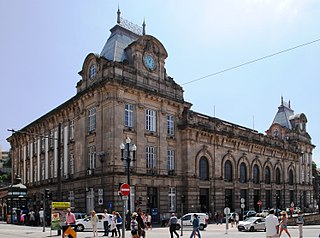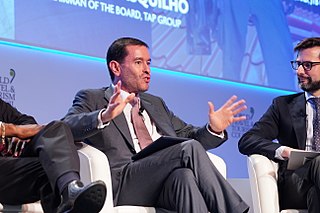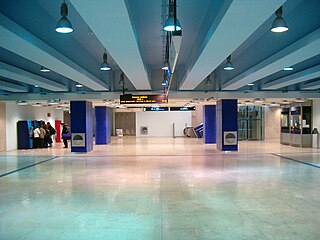Related Research Articles

CP — Comboios de Portugal, EPE is a state-owned company which operates passenger trains in Portugal. Before June 2009, CP stood for Caminhos de Ferro Portugueses although the company has been using its current designation as a brand name since 2004.

The Monastery of the Mónicas, located in São Vicente, Lisbon, was a Portuguese nunnery dedicated to the mother of Augustine of Hippo, Saint Monica. It later became a prison.

In February 2009, the government of Portugal announced plans to build a high-speed rail line from Lisbon to Madrid; this plan was cancelled in March 2012 amidst a bailout programme of financial assistance to the Portuguese Republic. The project was valued at €7.8 billion and the government had claimed it would create 100,000 jobs. The line would link to Spain's Southwest Corridor.
The CP Urban Services network is the commuter train network of Metropolitan Lisbon and Metropolitan Porto, Portugal. It connects the city centers with the suburbs.

The Santa Apolónia Station is the oldest railway terminus in Portugal. Situated in the civil parish of São Vicente, in the central part of the municipality of Lisbon, on the northern margin of the Tagus River in the historical district of Alfama.

São Bento Railway Station is a 20th-century railway terminal in the civil parish of Cedofeita, Santo Ildefonso, Sé, Miragaia, São Nicolau e Vitória, in the municipality of Porto, district of Porto. The English translation of São Bento is Saint Benedict. The station is located in the Historic Centre of Porto, which has been declared a UNESCO World Heritage Site and as a National Monument of Portugal.

The Campanhã Railway Station is a 19th-century railway station in the civil parish of Campanhã, in the municipality of Porto, district of Porto. Opened in 1877, it is connected to the Porto Metro, with local intercity and commuter service. The railway station provides Lisbon to north access, a through-station, and not a terminus station, serving the Lisbon-to-north allowing through running of trains from Lisbon to the north of Portugal.

The Palace of the Counts of Penafiel, commonly known as Penafiel Palace, is a Portuguese palace located in the civil parish of Santa Maria Maior, in the municipality of Lisbon. It serves as the global headquarters of the Community of Portuguese Language Countries, also known as the Lusophone Commonwealth.

Roma is a station on the Green Line of the Lisbon Metro. The station is located on Avenida de Roma, near the intersection with Av. dos Estados Unidos da América, enabling access to the Roma-Areeiro railway station nearby.

The Castle of Castelo Bom, is a medieval castle in the civil parish of Castelo Bom, municipality of the Almeida in the district of Guarda in the Centre region of Portugal.

Miguel Reis Antunes Frasquilho is a Portuguese economist, politician, and executive, currently serving as Chairman of the Board of TAP Air Portugal, Portugal's flag carrier airline. He also serves on the Olympic Committee of Portugal.

The Port of Lisbon is the third-largest port in Portugal, mainly on the north sides of the Tagus's large natural harbour that opens west, through a short strait, onto the Atlantic Ocean. Each part lies against central parts of the Portuguese capital Lisbon. Due to its strategic site between Europe, Africa, and the Atlantic, it is one of the most accessed and used in Europe. For container ships it begins with a 1080-metre mooring, with cranes, south of a thin, rectangular, pleasure boat marina. It is north-east of the centre of the strait-spanning suspension bridge, the Ponte 25 de Abril. Continuations are to the north-east. These are a bank-side cruise ship terminal next to the old Alfama district, followed by multi-use harbour-side terminals at Xabregas, Grilo, Beato ) and Braço do Prata, Marvila (Lisbon).

Oriente is a station on the Red Line of the Lisbon Metro. The station is located in Lisbon, between the Cabo Ruivo and Moscavide stations.

Santa Apolónia station is the southern terminus on the Blue Line of the Lisbon Metro.

Restauradores station is on the Blue Line of the Lisbon Metro.

Entre Campos station is part of the Yellow Line of the Lisbon Metro.
The following is a timeline of the history of the municipality of Setúbal, Portugal.

Linha de Cintura, originally called Linha de Circumvalação de Lisboa, is a railway line in Lisbon, Portugal. The half circle route was opened in 1888 and connects all radial lines with stations in Lisbon: Cascais, Sul, Sintra/Oeste, and Norte. There are two railway triangles, one in Sete Rios, and another in Xabregas. It crosses all four Lisbon Metro lines, and connects to three of those at four stations.

Ramal de Matosinhos, originally called Ramal de Leixões, was a metre-gauge railway line which connected the stations of Senhora da Hora, on the Linha do Porto à Póvoa e Famalicão, to the Port of Leixões, in Portugal. It was built in 1884 to connect the port to the São Gens quarry. Later, it was adapted to passenger and freight transport. Commercial service began on the 6 May 1893. The line was closed on 1 July 1965. In the 2000s, part of the trackbed was used for the construction of Porto Metro Line A.
References
- ↑ CM Jornal - Galeria de horrores nos comboios da CP
- ↑ Público - "Nunca ninguém me encostou à parede", diz Manuel Frasquilho, ex-presidente do Metro de Lisboa
- ↑ Associação das Empresas de Construção e Obras Públicas - Metro já tem nova administração
- ↑ Porto Canal - Manuel Frasquilho "desagradado" com tratamento dado aos gestores públicos
- ↑ CDS-PP - Hélder Amaral intervém durante audição de Manuel Alcindo Antunes Frasquilho
- ↑ Sol - Swap: Ex-presidente do Metro do Porto responde hoje na Comissão
- ↑ Diário de Notícias - Metro de Lisboa favoreceu empresas de Godinho
- ↑ Jornal de Negócios - Porto de Lisboa vai reforçar tráfego de contentores por via férrea e fluvial
- ↑ Transportes em Revista - Manuel Frasquilho: Presidente da APL «O Porto de Lisboa é para continuar»
- ↑ Porto de Lisboa - Associações a que a APL pertence e trabalho desenvolvido
- ↑ Porto de Lisboa - Presidente do Porto de Lisboa eleito para a presidência de organização internacional de colaboração entre cidades e portos
- ↑ RETE Digital - Manuel Frasquilho
- ↑ RTP - Porto Lisboa define plano estratégico com aposta mercadorias e turismo
- ↑ CEEP Portugal - A Regulação dos Preços Como Instrumento de Regulação Pública dos Serviços de Interesse Geral
- ↑ REFER - Rede Ferroviária Nacional defende que o atraso é assunto do Governo
- ↑ Portos de Portugal - Faleceu Manuel Frasquilho, Antigo Presidente da Administração do Porto de Lisboa [ permanent dead link ]
- ↑ Administração do Porto de Lisboa- Faleceu Manuel Frasquilho, antigo Presidente da Administração do Porto de Lisboa
- ↑ Transportes em Revista - Manuel Frasquilho: Faleceu antigo presidente do Metro de Lisboa
- ↑ Méditerranée - Le développement stratégique et durable du port de Lisbonne